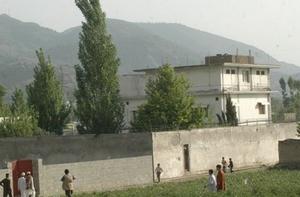TerrorismOBL: Hiding in plain sight
Osama bin Laden had been living in his walled Abbottabad compound for nearly ten years, within sight of an elite Pakistani military academy, and gone completely unnoticed. According to a scathing official Pakistani report, the incompetence and negligence of Pakistan’s Inter-Services Intelligence (ISI) failed to realize that the world’s most sought-after terrorist leader had been living in Pakistan, until he was killed in a night-time raid by U.S. Navy SEALs on 2 May 2011.

The now-destroyed bin Laden compound in Abbottabad // Source: commons.wikimedia.org
Osama bin Laden had been living in his walled Abbottabad compound for nearly ten years, within sight of an elite Pakistani military academy, and gone completely unnoticed.
According to a scathing official Pakistani report, the incompetence and negligence of Pakistan’s Inter-Services Intelligence (ISI) failed to realize that the world’s most sought-after terrorist leader had been living in Pakistan, until he was killed in a night-time raid by U.S. Navy SEALs on 2 May 2011.
According to IBN Live, the widely anticipated 336-page report provided evidence of incompetence of almost every level of Pakistan’s intelligence organization. This failure, along with the failure of the ISI to detect CIA activity on Pakistani soil, and the attack that followed, have severely strained U.S.-Pakistani relations. The report also criticized the United States for what it called the “illegal manner” in which the raid was carried out.
Surprisingly, the report did not avoid mentioning the possibility that rogue elements within the ISI had aided bin Laden in hiding. Some U.S. policy makers had been suggesting for some time the collusion of the ISI and government in bin Laden’s avoiding capture, a suggestion that Pakistani leaders had dismissed. Such assistance is a very sensitive topic to even mention in this type of report. The report was based on interviews with 201 people, including bin Laden family members, army and intelligence officials. It shows bin Laden as a paranoid individual who was constantly on the move to avoid being detected.
The report claims, as many in the U.S. believed, that bin Laden entered Pakistan from the Tora Bora region of Afghanistan some time in 2002, while his family moved from Kandahar in Afghanistan to Karachi shortly after the attacks on the World Trade Center and Pentagon.
The report maintains that he lived, over a period of time, in South Waziristan, Bajaur, Peshawar, Swat, and Haripur, successfully keeping a low profile. The bin Laden family lived extremely frugally, and never appeared publically.
Bin Laden and his family maintained limited security, never ventured outside the compound, and had no visitors, not even al Qaeda members. The minimal support group that was with him, the report maintains, blended in with the community. In short, bin Laden did nothing to cause people to wonder who was living in that Abbottobad complex.
The report concluded that bin Laden’s success at hiding in plain sight was more the product of government and intelligence incompetence than bin Laden’s measures, though to be sure, bin Laden did nothing to help himself be noticed.
